Volleyball drills for technique setting / overarm technique
Goal: Libero training and defense
- T plays in tempo the balls to SV.
- SV set-up (2nd tempo) to A (position 3) --> targeted attack to position 1 or to B (position 4) --> targeted attack to position 6.
- L starts from pos 6 + defense to SV2
Extension 1 : After defense from L to SV, set-up to position 4 where C attacks (aimed)
Extension 2 : L2 defended attack from C, C is going to catch ball.
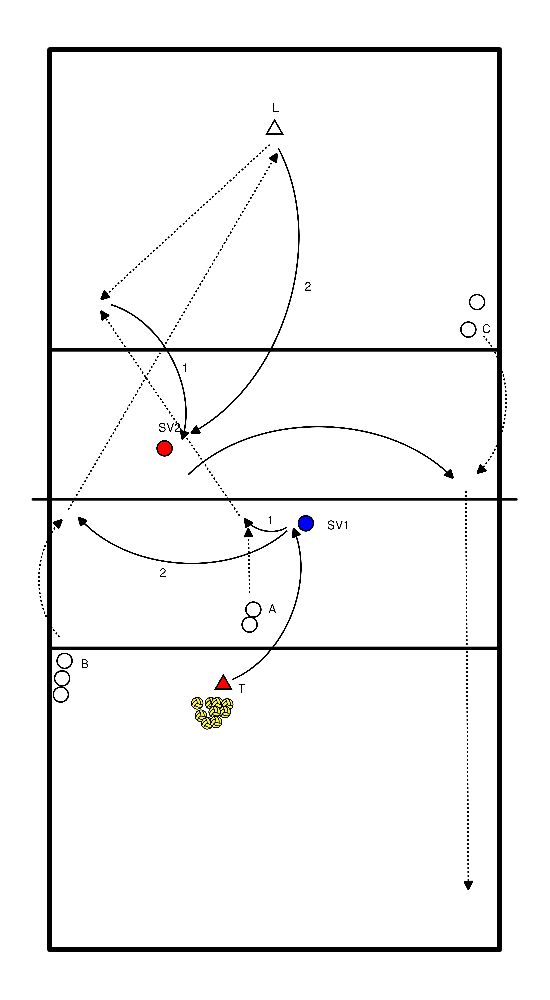
Purpose: peripheral view.
- C plays the ball to L.
- L plays the ball to pos 3/2 --> SV2
- Meanwhile, B3 moves to pos 2 or 4. (draw. to 2)
- SV2 setup to the pos. where there is only one block.
- C goes blocking
- A attacks.
Meanwhile:
- T plays ball to SV1
- SV1 setup to attacker where there are two blocks.
Extension : field defense.
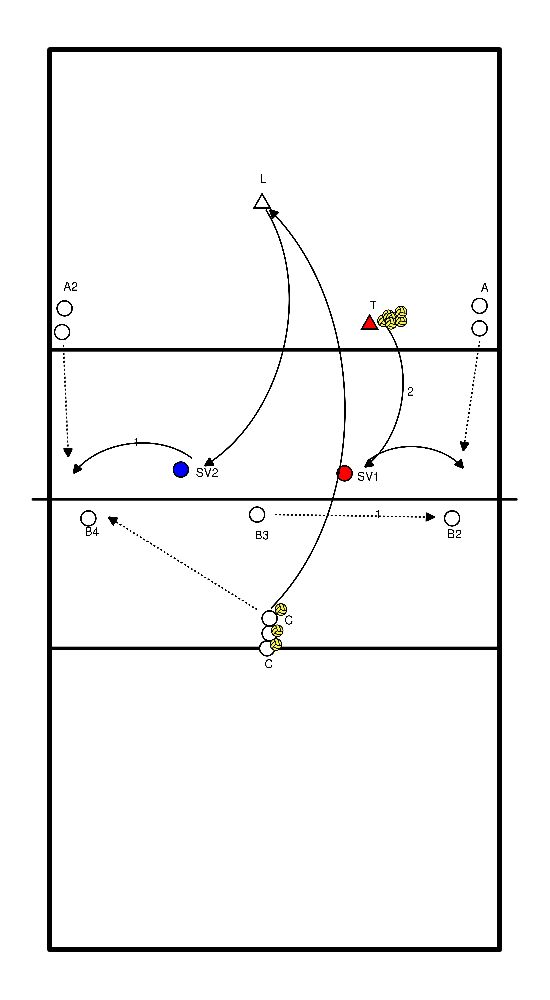
Goal of the exercise is, the playmaker must try to make sure that on the other side of the net a double block can not be formed.
- T plays the balls at a high pace towards pos. 3.
- SV walks in and gives set-up for -or backwards to fool the block.
- B tries to come to a drawbar block on attack.
- SV passes around T after set-up.
- SV1 & 2 switch positions after each set-up.
Expansion :
- Add field defense. (Liberos)
- B's play ball high back over to attacker passing towards pos 3/2
- Exercise starts again from pass attacker.
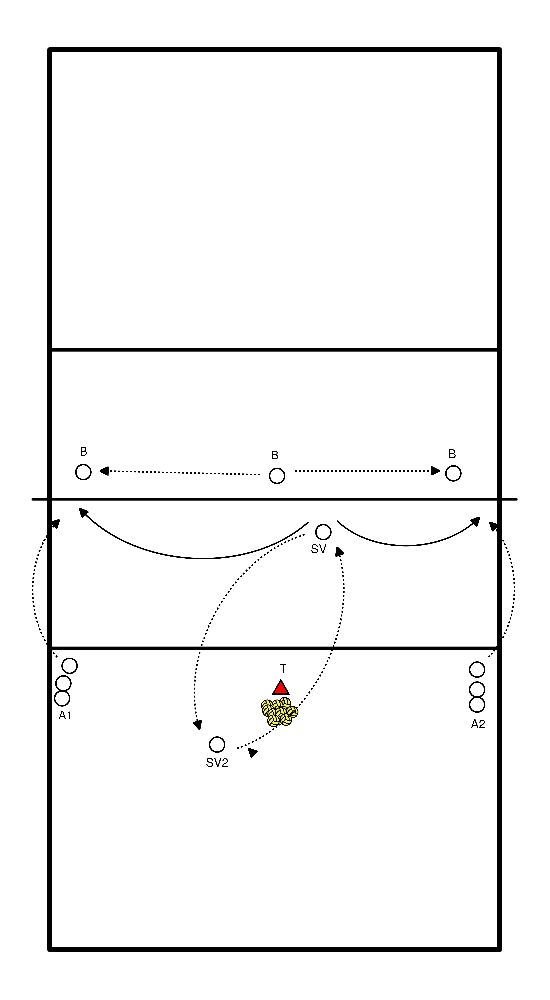
The goal of the core is, that the players can play the ball far overhead
- The players face each other in pairs and play overhead
- Hands well above the head, from the legs, body stretching and point towards the ball when releasing
- The players stand further and further apart from each other.
- Then we form two rows diagonally across the field and we play BH, chasing your ball
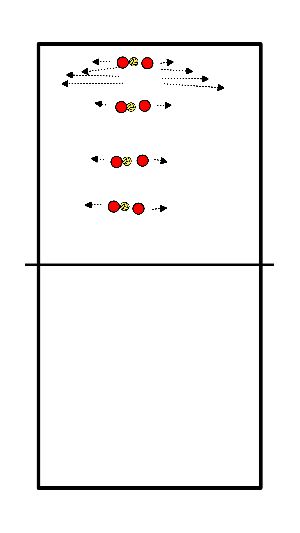
- Pass the ball overhead to each other in a snake-like figure
- Two rows of players that face each other.
- No. 1 plays the ball straight over and connects at the end of the snake.
- Nr 2 plays the ball diagonally over and connects to the end of the snake and so on.
- Hang on as long as possible (field around!)?
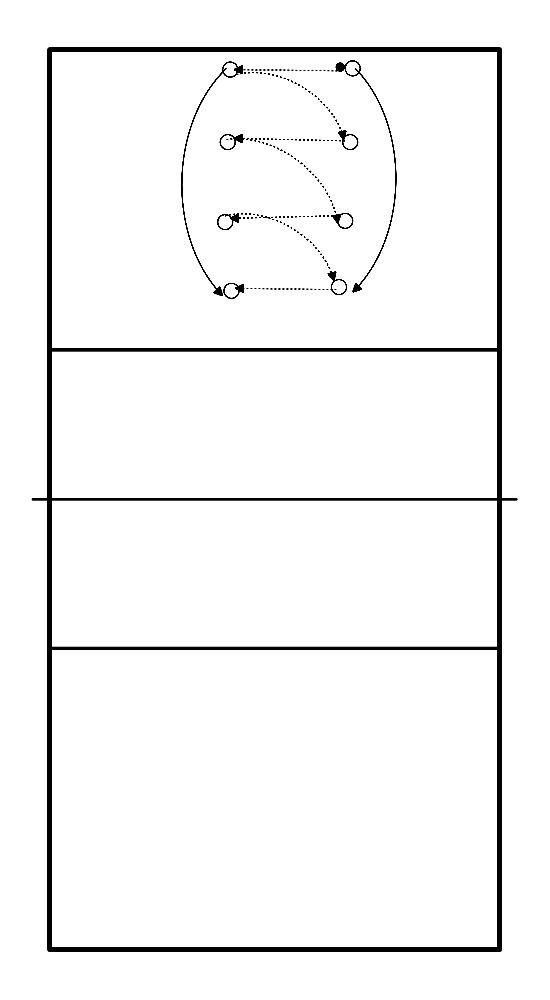
Divide "field" in 4 boxes. Exercise can be done with 2 persons at the same time, in which every player controls someone. The ball has to be played overarm, playing the ball high, and get to the other side like this. ;
- Divide the field in 4 boxes, playing the ball in every box at least 3 times.
- Every player gets 2 turns, in which the best turn counts.
- How far are you going to get
Directions for post holders
- Play up at least 3x per box: otherwise you cannot proceed to the next box
- The turn is over, when:
- the ball drops on the ground
- the player has both feet outside the box (1 foot outside the box is allowed!).
- the ball is not played high enough above the head (pay close attention!)
- Play at least 50 cm above the head.
- Every new turn start in the first box.
- The lines are part of the box (with regard to foot fouls outside the boxes).
- You are in pairs bsp;
- The one has a tennis ball, and the other a cone.
- One is holding the cone in a triangle and tries to catch the tennis ball thrown by the other.
- The catcher then tries to push the ball to the thrower.
- You do this 10x and then change.
- Also pay attention to leg work
The hands are positioned like this:
- The circle is the cone.
- The point of the cone has to point to the nose of the kid.
- You need little cones.
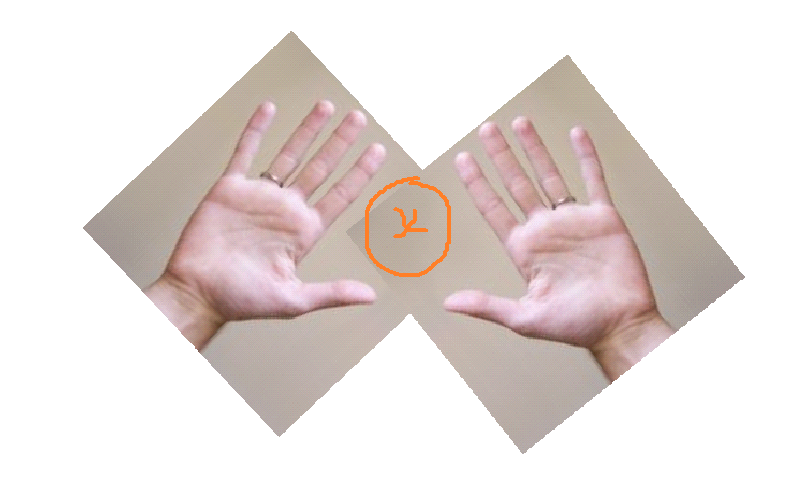
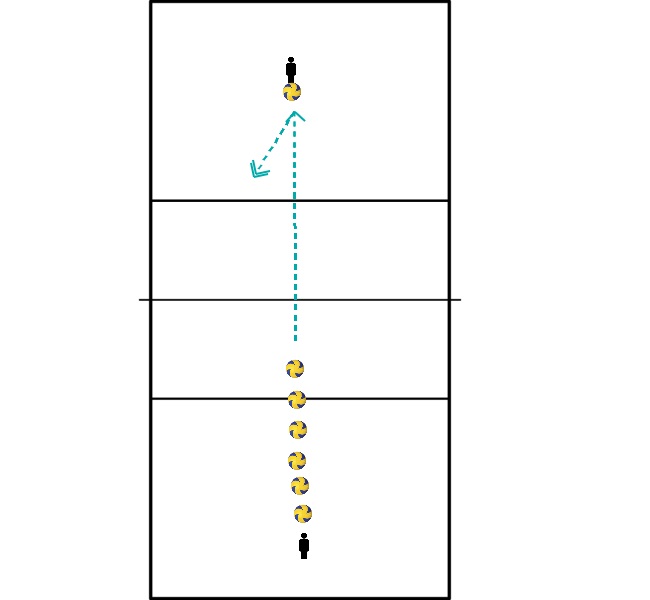
This exercise can also be done as a game against a group on the other field!
- There is a line of kids with a ball at a cone in the back of the field and 1 kid in the other field
- Kid 1 is going to the net while playing overarm with the ball (if the ball is dropped, start over)
- around 1m from the net, you play the ball overarm over the net to the kid (x) standing there
- the kid standing there has to pass the ball and catch himself (walks with the ball to the line of children)
- kid 1 goes underneath the net and takes the place of kid (x)
- kid 2 now goes to net overarm playing and plays the ball to kid 1
- etc. etc.
(variation or harder)
- there is a line of children with a ball at a cone in the back of the field and 1 kid in the other field
- Kid 1 is going to the net while playing overarm with the ball (if the ball is dropped, start over)
- around 1m from the net, you play the ball overarm over the net to the kid (x) standing there
- kid 1 quickly goes underneath the net and takes the mid forward position
- the kid standing there (x) has to pass the ball and play to the mid forward who catches the ball and gives it to kid (x)
- kid (x) walks with the ball to the line of children
- kid 1 takes the position of kid (x)
- Kid 2 now goes to the net while playing overarm with the ball and plays the ball to kid 1
- etc. etc.
- overarm and underhand
- Line of players A (+- 4 players) in the middle of the field with a ball
- Player 1 is center forward, and is properly thrown to by first player from line A
- Player 1 plays ball overarm in the basket
- bend elbows
- stretch elbows and point after ball
- Player at the basket catches and joins line A
With this exercise, younger children can practice overarm throwing.
- Give everybody a ball and have them show how they play overarm
- Is this not correct (for example, no pizza slice, or under the head), correct them, show how it has to be done.
- Have them throw against the wall, this provides lots of ball contact.
- Make pairs and have them throw over the net, to learn them to play high.
- Meanwhile, correct technique mistakes, but stay positive.
- Ask afterwards what they have learned, to make them think about it again.
- every kid takes a ball and stands as close to the wall as possible.
- Try to play the ball against the wall as often (and as fast) as possible
- per pair 1 ball.
- The one person (1) keeps the ball in front of him with stretched arms
- the other stands before him,
- bends the knees
- and tries to play the ball out of the hands of person 1
- someone is one the chest with a hoop
- the sv receives the ball from the back field.
- Then play the ball overarm through the hoop
To make sure that players learn to play in a rhythm, the ball has to be under way for 2 seconds each time (21-22).
- All players will try to play synchronously at the same time.
- This starts with overarm.
- The next form is that the player in the back field is going to play underhand and the player on the net overarm.
- In this way it can be extended.
he most important thing is that the players keep the ball in the air for 2 counts.







